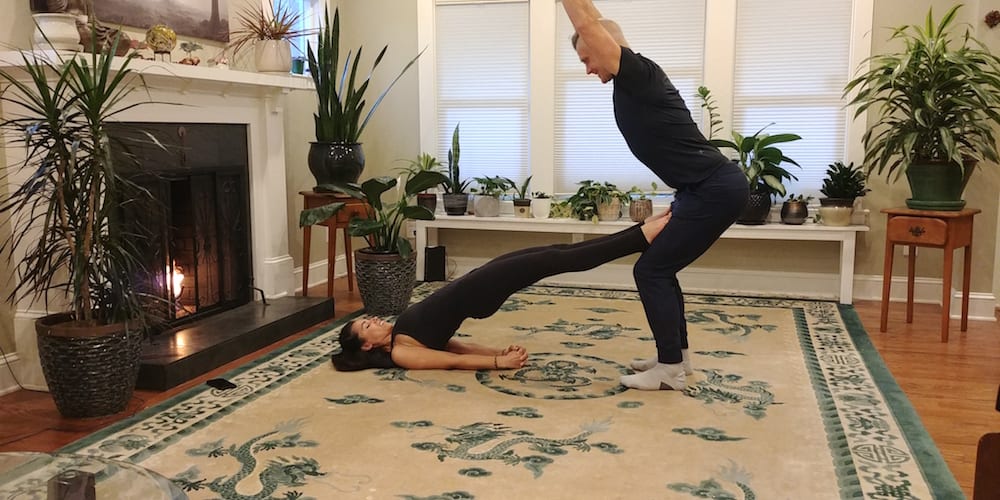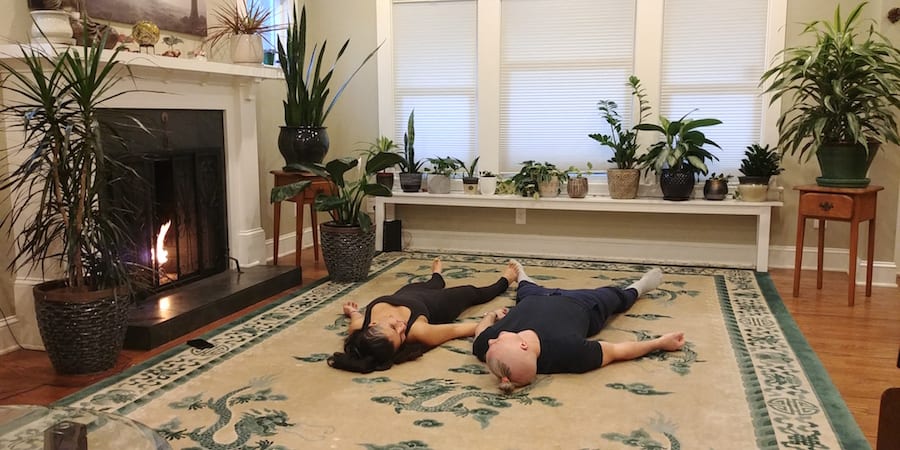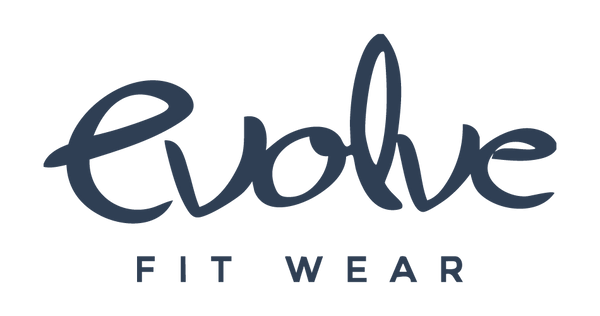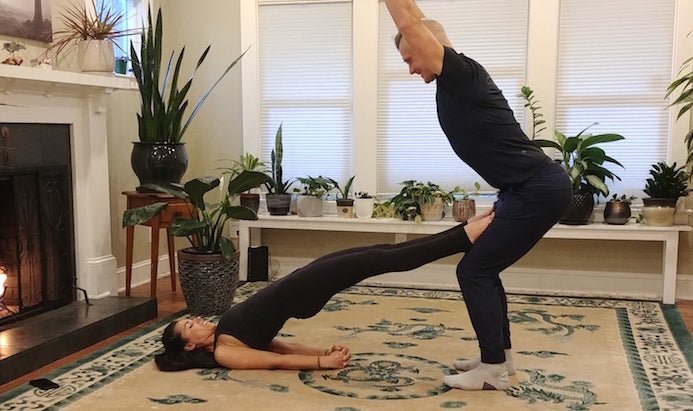We’re living in some interesting times right now where touch and closeness to other people can be hard to come by. If you are one of the lucky ones who have access to a friend or a partner, you might be looking for new ways to connect. With a traditional yoga practice, we are often focused within.
But there’s another kind of yoga out there that can be just plain fun. This would be yoga poses for couples at home. Partner yoga can move from safe beginner poses to more acroyoga-focused shapes that might require a spotter and a willingness to honestly assess your abilities and safety.
Today, we will focus on poses that won’t require a spotter in most circumstances (always be the judge of your own capabilities and watch for any obstacles that could hurt you if you came down on them). We will instead look at a variety of easy yoga poses for couples and partners to some harder variations that require a little more body awareness and willingness to laugh a whole lot.
While the movement itself has many benefits for the body, the act of doing yoga with a partner (whether romantic or platonic) adds an element of playfulness, laughter, and connection that can be difficult to find in such a neat and tidy package like partner yoga. Our two friends from Fuel-PDX will demonstrate how these poses are done!
Seated Meditation – Back-To-back or Knee-To-Knee
Seated meditation is the way that many people begin a yoga class, whether they are doing a solo practice or working with a partner. Connecting with your breath is important before you begin this practice, and so is connecting with your partner (whether platonic or not).

You can find an easy seat either facing each other or back-to-back. Personally, facing each other seems really intense and a beautiful way to connect. You can sit with your legs crossed and knees touching each other. Hands can rest at your sides, on your legs, or maybe on your partner’s legs or holding hands. Really, it’s all about what you both are feeling in the moment. You can sit with your eyes closed, or maybe take it a step further and gaze into each other’s eyes for a few minutes of deep and mindful breathing.
Partner Seated Straddle Forward Fold
To get a little blood flowing, you can ease into a deep or shallow stretch, depending on your needs. A seated straddle forward fold can be intense if you have tight hips and hamstrings. That’s ok, you can still do this one! Now comes the magic of partner yoga poses: communication. Facing each other, sit in a straddle position and allow your feet to touch. If one person is very tall and the other is short, one person can put their feet on the other’s ankles or shins. You don’t want your knees rolling forward, so that might mean taking it a little easier and narrowing your straddle so your knees can continue facing the sky.

Now, hold hands, wrists, or forearms. Everyone needs to keep their spines long, knees facing up, and then lean from the hips. One person will start to lean backwards while the other folds forward. If you feel your spine starting to round in the forward fold, you’ve gone past the point that you need to stop. Communicate to the person leaning back when it’s time to stop because they aren’t the ones stretching their hamstrings yet. Hold it for as long as you want, and then start to reverse the lean and fold so the other person gets a turn.
Standing Forward Fold
The standing forward fold is an upright version of this, with slightly different body logistics. For this one, stand back to back, but leave a few inches of space or you’ll booty bump each other as you fold. If you have tight hamstrings or hip flexors, allow for a bend in the knees.

If you are super flexible, you should also have a micro-bend in the knees. Depending on the flexibility of both partners, you can start to fold forward, allowing the head to relax towards the floor as much as possible. From here, you’ll probably be giggling a little bit, and you’ll reach towards each other’s arms. The super flexible will likely be able to grab each other’s biceps or shoulders, and the tighter bodies can grab hands or wrists. There is no wrong way to be in these shapes. The important thing is to listen to your body, communicate, and have fun.
Seated Twist – Facing Towards Or Away From Each Other
Back into our seats! A seated twist is a great way to warm up the spine in a different direction. When you begin most yoga practices, you want to warm up the spine in all six directions that it can go for optimal health: forward bend, backbend, right side bend, left side bend, left twist, and right twist.

Your partner almost acts as a prop during a seated twist, giving you something different to hold onto as you twist. Whether facing each other or with your backs to each other, twist in the same direction (you’ll appear to be going opposite directions), and use each other’s bodies as some leverage to hold the twist a little longer. You don’t have to go super deep into these twists. The important thing is to keep the spine long, with the crown of your head reaching up towards the sky, and twist from the rib cage (not the shoulders).
Don’t Rock The Boat Pose
Boat pose is a great one all around, whether your solo or attempting two person yoga poses. For this partnered pose, you’ll want to sit facing each other, knees bent, with your feet flat on the ground, and your toes touching. You can grab hands or wrists here (whatever you can reach), and start to walk the soles of the feet together, keeping your knees bent. If you have tight hamstrings or hip flexors, this might be as far as you go.

Listen to your body. If you can and it feels good, you can start to straighten your legs. While in this partnered boat pose, always keep your spine long and extended! Your core will thank you as it burns away.
Boat pose benefits the core, the spine, the hamstrings, and so much more.
Child’s Pose/Fish Pose – An Intermediate Variation
If you want to take your fish pose variation a little further, and allow both people to experience maximum benefits at the same time, then you need to try this child’s pose variation.

The first person can come into child’s pose.
Check out this article for a step-by-step guide on getting into Child’s Pose. Once the first person is in position, the second can slower lower their back down onto the person in child’s pose (both of your heads should be facing the same way). The fish person can keep their feet planted and their knees bent. The more fish person bends backwards into their shape, the deeper the child’s pose position goes. Communication is always important to make sure everyone is comfortable in their body.
This variation is beneficial for pretty much the entire body as you move through both poses. It can open the hits, release tension in the spine and shoulders, open the chest, and so much more.
Assisted Fish Pose
Assisted fish pose is great for opening the shoulder, the chest, and lengthening the spine. Assisted fish pose is a bit of a weird one, but can feel so good if done right. If you’ve ever used a block to support between the shoulder blades during fish pose, this is similar, except you’re using a person as your prop.

The person being the prop will lie on their back with their feet flat on the floor with knees bent and pointing towards the ceiling. The person doing the pose will gently lower down so that their upper back (just below the shoulder blades) is on the knees. The prop-person doesn’t want a super deep bend in their knees unless the receiver likes the intensity. The person going into fish will bend their own knees, feet flat on the floor, and allow the upper part of the shoulders and head to rest on the prop-person’s thighs.
Forward Bend/Fish Pose – An Advanced Variation
If you really want to feel some things in your body, try these more advanced yoga poses for two people. A seated forward fold can be intense if you have tighter hamstrings (and even if you don’t). Add a person leaning over your back, and your legs are going to light up when you’ve hit your edge. It’s important to communicate here so that everyone stays safe.

The first person will sit and begin the fold from the hips (as opposed to just rounding the spine over). Stop when it feels like it’s just right. Then allow the person behind you to slowly lower their back down onto yours. If you have very tight hamstrings, this partner pose most likely won’t work, as you won’t be able to forward fold far enough for your partner to get into the fish pose. That’s completely ok! Just do what feels right for you.
This advanced variation will definitely work the hamstrings, hip flexors, opening the chest, and lengthening and strengthening the spine.
Double Plank
Double plank is a fun and challenging partner pose. You’ll most likely laugh a lot in attempting this, and because you are adding in some stacking and height, it’s important to do it as safely as possible.

Double plank is just like it sounds. Each of you will be in plank pose (instructions here if you need to know how to do plank pose), but you’ll both face opposite directions, and one of you will be stacked on top of the other. To do this, the bottom planker needs a solid plank. You’ll be holding yourself in this shape for a minute and you don’t want to start sagging down the middle and hurt your body. Once the bottom person gets into plank, the top planker will first grab both ankles of Bottom Planker for support. Then they will carefully place the ball mound portion of their feet onto the shoulder area of the Bottom Planker. You want to keep your feet soft, Top Planker. No one wants stabby toes going into their back. Voila! You’ve created a double plank shape.
Plank works the entire body. When you stack it, you’ll both glean the full body benefits, as well as the positive side effects that come with play, touch, and communication.
Double Downward-Facing Dog
We get a little more wild, taking one step above the double plank, and that is with the double downward-facing dog. This might not seem so tricky because everyone gets to keep their hands on the ground, but a double downward-facing dog is going to invert the top person pretty steeply.
Whoever is on the “bottom” will get into a regular downward-facing dog (heres on article on how to do downward dog). Then the next person gets to semi-straddle the first person’s head (partner yoga gets silly), and brings their hands down like they would for downdog. Then they’ll carefully step one foot up towards the hip of the bottom person, and then the other foot. It should feel like a support inversion for the top version, except their body is in the shape of a downward dog.

Downward-facing dog is a great workout for the shoulders, the arms, the hamstrings, While the bottom person will get the benefits of a gentle inversion (head below the heart), the top person will experience benefits of a more intense inversion, as a lot of weight will be in their hands.
Supported Chair/Shoulder Stand
Supported chair and shoulder stand are an interesting combination for those looking to get a little funky. To achieve this partner pose, one person will be standing and facing the other person, who will be sitting on the ground facing the standing person. The person on the ground will lay their back on the ground and place their feet flat on the standing person’s thighs.
From there, the standing person can help support the sitting person by holding their ankles, keeping their feet firmly in place. Now the standing person can start to sink down into a chair pose, and the sitting person will push with their feet to lift their bum off the ground and start to press into a modified version of a shoulder stand.

Chair pose builds strength in the legs and core, while shoulder stand hits the core in a different way. Combining and alternating between these two poses allows for a lot of laughter, as well as a new way to strengthen your body while also building human connections.
Partner Savasana
One of the best ways to end any type of yoga session, partner or not, is reconnecting with yourself and allowing a moment of recovery. What better way to achieve that than a partnered savasana. This is likely the easiest one, especially if you incorporate it towards the end of a fun and physically challenging practice. If you aren’t familiar with savasana (corpse pose), you essentially lay flat on your back and rest. To include your partner, you could hold hands if it’s that kind of relationship. You could lay with feet touching, or just side by side without touching yet together.

Savasana is a wonderful opportunity to focus on relaxing the body, bit by bit. When you’re on your back, you can breathe easier into the belly, getting those full breaths that allow your mind to find calm.
Doing yoga poses for two people is such a fun way to reconnect with yourself, but also with those closest to you. It allows for the opportunity to get playful, to experience the healing powers of safe physical touch, as well as the benefits of moving your body. Communication should be at the center of every single one of these poses for couples, and it is a powerful way to practice advocating for your own needs and limitations. So have fun, and give some of these shapes a try!
Big shout-out our friends at Fuel-PDX in Portland, OR for showing us how these poses are done!
Have you tried any of these? Comment below -we'd love to hear from you!



